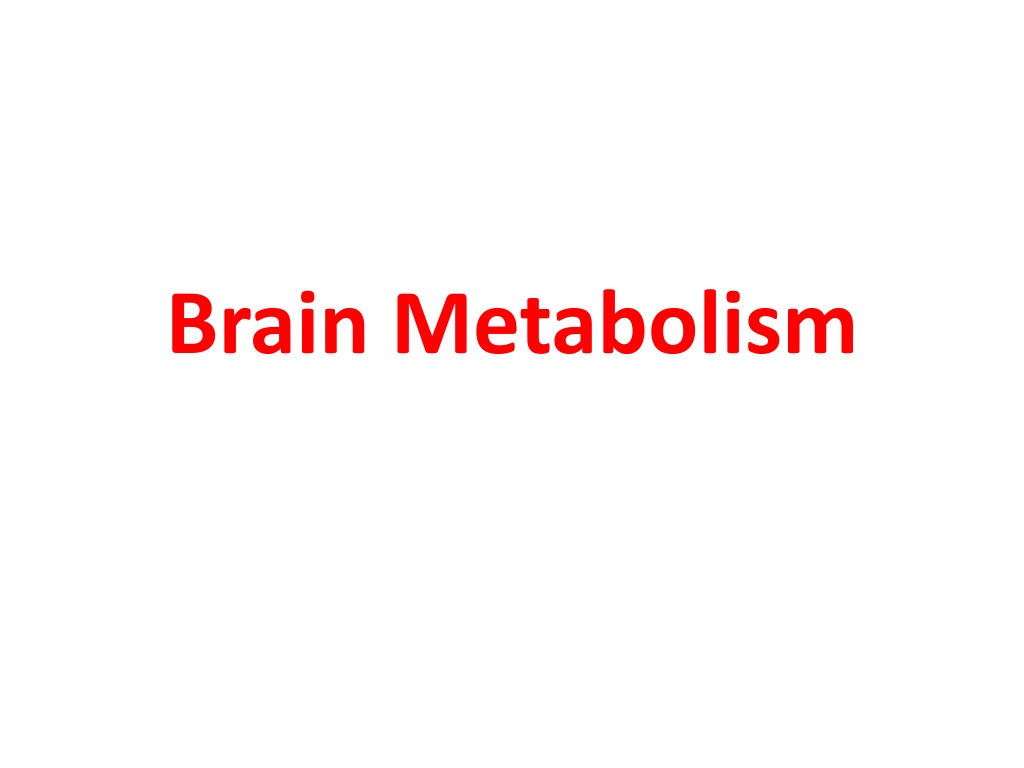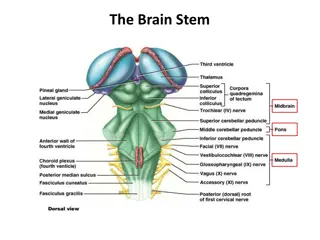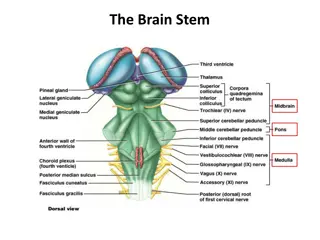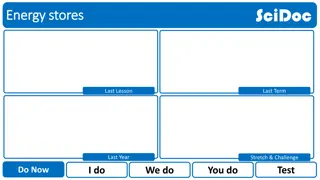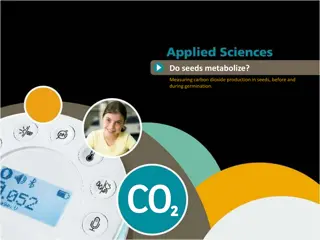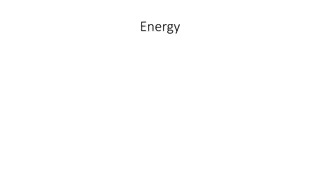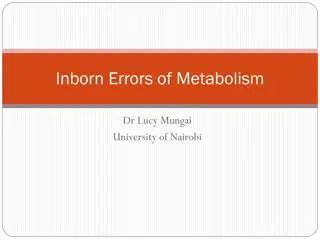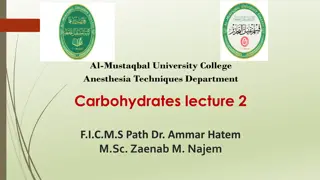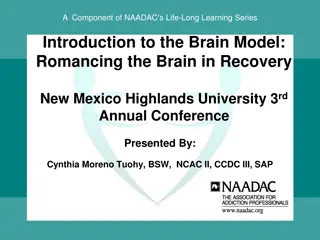Brain Metabolism and Energy Production
Brain metabolism involves the utilization of substrates like glucose, amino acids, and lipids for energy production, crucial for brain functions such as excitation, conduction, and ion transport. Oxygen supply plays a significant role in supporting brain energy metabolism. Various substrates are utilized in cerebral tissue for energy production, with glucose being the primary substrate. The significance of O2 supply to brain energy metabolism is paramount for maintaining brain function.
Download Presentation

Please find below an Image/Link to download the presentation.
The content on the website is provided AS IS for your information and personal use only. It may not be sold, licensed, or shared on other websites without obtaining consent from the author.If you encounter any issues during the download, it is possible that the publisher has removed the file from their server.
You are allowed to download the files provided on this website for personal or commercial use, subject to the condition that they are used lawfully. All files are the property of their respective owners.
The content on the website is provided AS IS for your information and personal use only. It may not be sold, licensed, or shared on other websites without obtaining consent from the author.
E N D
Presentation Transcript
Topics 1- the need of brain to energy. 2-substrates used for energy production in brain. and metabolism of carbohyrate in brain 3-Significance of oxygen supply to brain energy metabolism 4-amino acid content in brain 5-lipids in brain 6-hypoxia effect on brain
1- the need of brain to energy. Energy is needed for: 1-Excitation and Conduction, which are reflected in the unceasing electrical activity of Cerebral tissue. 2-Electrical energy is derived from chemical processes. 3-Energy consumption used for active transport of ions to sustain and restore membrane potentials.
Substrates used for energy production in cerebral tissue: Glucose is the major substrate for energy production in cerebral tissue. Cerebral tissue utilizes glucose directly from arterial blood. About 0.1% Glycogen is stored in Cerebral tissue. Insulin is not required for uptake of glucose by cerebral tissue. When blood glucose is low, Glycogen stored in brain is used to maintain cerebral metabolism for a very short duration.
Mannose can easily cross the bloodbrain barrier (BBB) and be converted to Fructose-6- Phosphate then joins glycolysis Mannose is not normally present in the blood and cannot therefore be considered as a substrate for cerebral energy metabolism; Fructose, Galactose, Lactate and Pyruvate have limited permeability across the BBB, therefore cannot directly serve as substrates for cerebral energy metabolism; Lactate and Pyruvate when formed within the BBB are useful metabolic substrates for cerebral metabolism;
Metabolizm of carbohydrate in cerebral tissue Aerobic and Anaerobic Glycolysis occurs in cerebral tissue. HMP shunt occurs in cerebral tissue mainly for production of NADPH, required for biosynthesis of Fatty acids and Steroids. Major substrate used in Blood glucose. Other Carbohydrates (Maltose, Fructose, Galactose, Hexose-phosphates) and Intermediate metabolites (Lactate, Pyruvate and Glyceraldehydes) are used only after their conversion to Glucose via Gluconeogenesis in the liver. These compounds act by raising Blood Glucose Level
Significance of O2 supply to brain energy metabolism: Brain represents 2 to 3% of total body weight of an average adult,however it utilizes 20 to 25% of the total Oxygen consumed. In children up to 4 years of age, the brain utilizes about 50% of the totalOxygenconsumed. Cerebral tissue utilizes Oxygen more than other tissues. Example, it utilizes about 20 times moreOxygen than muscle tissue at rest.
Oxygen consumption varies throughout the brain: Grey matter utilizes about twice more Oxygen than White matter Sleep reduces cerebral Oxygen uptake by only 3%. Amount of Oxygen stored in the brain is extremely small compared to the rate ofutilization. Brain requires continuous replenishment of its Oxygen via the circulation; Consciousness is lost when Cerebral bloodflow is interrupted.
Reduced cerebral Oxygen uptake occurs under certain conditions that lead to depressed consciousness: Insulin induced hypoglycemia, Diabetic coma, Cerebral tumors, Uremia,hepatic coma Exposure to depressant drugs used during surgery
List some uses of O2 consumed by cerebral tissue? Energy metabolism via Oxidative Phosphorylation Maintenance of energy component in BBB Impulse transmission (Ion pumps). Signal transduction. Functioning of specific enzyme systems: Mixed Functional Oxygenases used in the biosynthesis of Neurotransmitters and otherbiologically active compounds.
The amino acid content in cerebral tissue Cerebral tissue contains: Very high conc. of free amino acids compared to plasma; Highest amount of free Glutamate, compared to any other mammalian tissue. Some unusual amino acids: e.g.Gamma- Aminobutyrate(GABA), N-Acetyl-Aspartate and Cystathione. GABA is an inhibitory neurotransmitter that acts by increasing the passage of Chloride ions through the Postsynaptic membrane of Neurons. Glutamateis involved in several metabolic processes: Biosynthesis of GABA, Detoxification of Ammonia and as Neurotransmitter.
Lipids in brain: The brain has the second highest lipid content behind adipose tissue, and brain lipids constitute 50% of the brain dry weightthe brain. The brain utilizes acylated lipids to generate phospholipids for cell membrane. 1-Fatty Acids of the brain :rich in long-chain polyunsaturated fatty acids (LC- PUFAs), particularly arachidonic acid (AA), eicosapentaenoic acid, and docosahexaenoic acid (DHA). 2-Cholesterol : an essential component of neuronal physiology during both development and adulthood. Cholesterol depletion in neurons impairs vital functions, including synaptic vesicle exocytosis, neuronal activity, and neurotransmission and results in synaptic loss and neurodegeneration . Clinically, deficits in cholesterol homeostasis in the CNS manifest as severe primary neurological disorders such as Neimann Pick C disease and Parkinson s disease 3-Apolipoprotein E-containing lipoproteins :ApoE play a major role in glia- neuronal lipid metabolism and acts as a ligand for multiple receptors in neurons, which interact with a number of downstream physiological processes.
How does hypoxia affect cerebral metabolism? After a brief period of hypoxia: There is drastic slowdown in Oxidative Phosphorylation. Rate of Glycolysis is increased. Lactic acid production is increased, which can consequently lead to intracellular acidosis. These changes are due to the Pasteur effect. Inhibition of Glycolysis in the presence of oxygen. Pasteur effect reflects the increased energy yield obtained via Aerobic metabolism of glucose as compared to Anaerobic metabolism.
Hypoxia causes an increase in Glucose utilization from cerebral blood stream, followed by a decrease in cerebral glucose concentration. Resulting is an increase in Lactic acid production in cerebral tissue. Gradual increase in Spinal fluid Lactate level occurs during hypoxia.
Quiz 1.The main substrate used for brain energy production is: A-glucose B-mannose c- amino acids D-starch
2-In hypoxic states, there is increase in a-spinal fluid glucose b-spinal fluid lactate c-brain amino acids d-brain glucose 3-Consciousness loss during Cerebral blood flow interruption due to: A-Lack of oxygen B-Lack of glucose C-Lack of glutamate D-lack of serotonin
